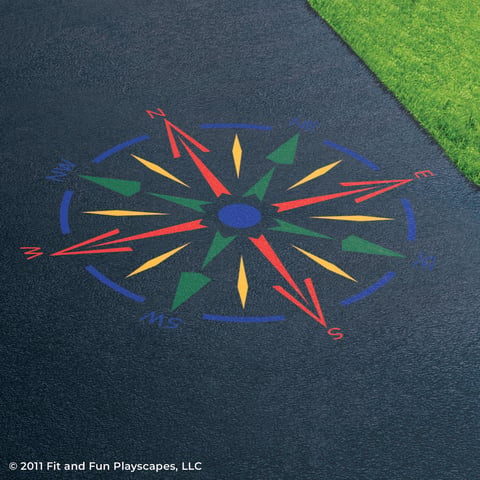Playground STEM: 7 Math and Science Ideas for Playground Markings
Updated March 9, 2025
Most playground painting ideas focus on how to get kids to move, develop their social skills, and engage in unstructured play.
But that’s only half the story.
You can also incorporate playground markings in the teaching process to help kids learn about the natural world or grasp abstract concepts — numbers, fractions, geometric shapes, and more — through organic and embodied learning.
And the best part is that you don’t need a lot of equipment to get started.
It only takes a few creative playground painting ideas, several reusable playground stencils, and some paint to turn an entire playground surface into a space for learning.
Our Favorite Playground Painting Ideas for Science and Math Games
Here are some fun and easy ways to tap into the underutilized potential of playgrounds to support math and science instruction:
1. Daisy Hopscotch®: Learn the Numbers and How to Count
Our best-selling Daisy Hopscotch® Reusable Stencil is a great tool for teaching young kids numbers and how to count from one to 12 (or more — the sky’s the limit!). Hopscotch – like Caterpillar Hopscotch and Skipadee The Dragonfly Hopscotch® – also helps improve balance and basic locomotor skills like hopping and jumping and can be played by groups of different sizes, including solo players.
2. Compass Rose: Learn the Cardinal Directions
Use our compass playground design to teach your students the cardinal directions beyond the four walls of the classroom. One way to do this is for kids to take turns standing in the center of the compass rose and follow your instructions as you call them out, i.e., hop to the North, jump to the East, walk backward to the Southwest.
Advanced players can play with their eyes closed, which makes for an excellent playground activity for improving balance, coordination, spatial awareness, and self-motion perception.
3. Bullseye: Learn To Add & Subtract Larger Numbers
With our Bullseye Playground Stencil, kids can become more familiar with adding and subtracting large numbers using mental math. With their eyes closed, each kid throws a flat stone or a similar object onto the bullseye twice. You then instruct them to add or subtract the numbers the stone landed on.
To increase the level of difficulty, simply have the kids throw the stone multiple times and ask them to add or subtract the 3 or more numbers their stones have landed on!
4. Animal Paw Prints: Learn About Animal Tracking
One of our most popular playground stencils, the animal paw print design, is a great tool to teach kids about different wild animals, their paw prints, the way they move, and more.
The design also doubles as a mini sensory pathway and can be used to prompt kids to walk, crawl, hop, or jump like the animals whose prints are painted on the playground.
5. Large Leaf Set: Learn About Different Tree Leaves
No science class is complete without learning leaf identification. Our Large Leaf Playground Stencil helps teach kids to distinguish the leaves of different tree species, such as elm, ash, maple, wild grapevine, and more.
If possible, follow up the playground activity with a trip to a local park or a botanical garden where the kids can test their knowledge of leaf shapes in a real-life setting.
6. Fraction Actionz: Learn Common Fractions
Fraction Actionz is one of our most sought-after playground stencils, and with good reason. The abstract concept of fractions can be a hard one for young learners to wrap their minds around. Our design leverages simple geometric shapes (squares and rectangles) and vibrant secondary and primary colors to create an easy-to-understand visual representation of how a whole can be divided into any number of equal parts.
The design can also be used to play fraction hopscotch. Kids throw a stone and jump or hop on the square on which it lands, then say the equivalent fractions for that square out loud, i.e., one-half equals one-quarter times two.
7. Door Angle: Learn Angles and Degrees
Even adults get these wrong. We often hear people talk about making a 360-degree turn in their lives, but what they really mean is a 180-degree change!
Our door angle reusable stencil is a great tool to teach kids the difference between the two from a young age. You can paint the design near a doorway to enable kids to check the degrees every time they open the door, but it works just as well on any playground space.
Do You Need More School Playground Painting Ideas?
At Fit & Fun, we’re always on the lookout for cool new ways to facilitate learning, get kids to move, and improve their interpersonal skills through fun playground interactions. Contact us to discuss any ideas you have for your playground or let us help you create a custom experience.










Leave a comment